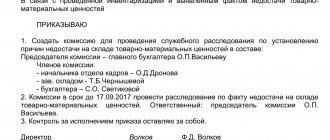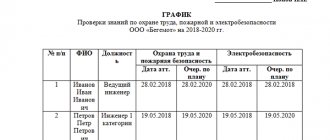Example of an order to conduct an internal investigation
Limited Liability Company "Egoist"
05/11/2022 Kaliningrad
In connection with the inventory carried out by Egoist LLC and the established fact of a shortage of valuables in warehouse No. 1,
I order:
- Conduct an internal investigation into the shortage of valuables in accordance with the inventory act dated 05/04/2022 in order to establish the conditions, causes, circumstances responsible for causing damage to persons and other facts.
- Create a commission to conduct an internal investigation to establish the causes and circumstances of the shortage in warehouse No. 1 of inventory items in the following composition: chairman of the commission: head of the personnel department Pyrov Viktor Orkhovich, members of the commission: head of the security service Dimitrov Pavel Sergeevich, chief accountant Ivleva Inna Romanovna.
- The commission should conduct an internal investigation by 06/01/2022. Responsible: chairman of the commission.
- I entrust myself with control over the execution of this order.
General Director Arkhipova Arkhipova S.T.
Chief Accountant Ivleva I.R. Ivleva
Head of HR Department Pyrov Pyrov V.O.
Head of Security Service Dimitrov Dimitrov P.S.
https://youtu.be/FHTC_NKZfaM
Advice. Determine what document will confirm the audit.
The employer needs to prove that the subordinates actually committed a gross violation of the established rules of conduct or the requirements of the job description. At the same time, the manager must document this fact by implementing a set of measures aimed at establishing the causes.
The commission then analyzes the available documents. During this stage, those documents that need to be finalized are studied.
All checks are carried out on the basis of Ministry Order No. 161 of 2013. Sometimes internal audits are not carried out according to the standards of the regulations, and this is due to the following circumstances:
- The inspection is carried out by a person who does not have the authority to do this.
- The inspection was ordered by other persons.
The main part of the order for internal inspection lists:
- The reason for the proceedings. For example, “due to official needs.”
- The essence of the procedure. For example, “conduct an internal investigation into violation of labor discipline by an employee (full name and position).”
- The composition of the commission that will deal with the proceedings. They write here that a special commission is being appointed to conduct an investigation. They also indicate which of the company’s employees will be included in its composition. For example, “head of such and such department (full name), employee of the human resources department (full name).”
- How will the results of the inspection be recorded? At the end of the investigation, the commission must issue a special act reflecting the results.
- Verification period. The director of the company determines the period during which the investigation must be conducted and sets a date for the commission to sign a report on the results of the inspection.
- Who controls the execution of the order to conduct an internal audit. For example, the document may contain the wording “I entrust control over the execution of the order to the employee (full name and position).”
During the inspection, you must follow the established rules for its conduct. In particular, issue an order in a timely manner.
A commission can be created even if the company has not yet suffered direct damage, but the employee’s actions could lead to similar consequences. The commission may be permanent and renew its work if necessary.
The inspection was carried out in accordance with the program issues agreed upon with the Head of the Department and the Deputy Head of the Department, in the presence of ____________________________________________________________.
If the investigation reveals the culprit, he can appeal the decision on any penalties through the court. To create a commission, the employer must issue an order.
Grounds for issuing an order to conduct an internal investigation
The reasons for issuing the order underlie the reasons for conducting the inspection.
Has the fact of violation of labor discipline or causing material damage become significant for the employer? Does he intend to take disciplinary action? Does he need to establish the fact and extent of the damage? Often the document includes such a column as the basis. That is, some document that became the basis for the verification. This could be a memo, an inventory act, an absence from work act, etc.
The head of the organization must remember that the order to conduct an internal investigation, the procedure and the final Act itself often become the subject of complaints to the labor inspectorate. All labor law standards must be observed. And, in fact, the order can also become evidence in the event of going to court.
The procedure for carrying out an internal audit
Prosecution for damage to corporate property or other violations is associated with the restriction of the rights of the violator, therefore, special attention should be paid to the procedure for organizing an internal audit.
Preparing an order to organize an official investigation is a right, not an obligation. Therefore, the manager independently decides whether it is advisable to punish a specific person for the identified offense.
Labor law provides for the following procedure:
- Identification of violation. Any official of the enterprise who prepares a memo to the head of the company can establish the fact of misconduct. Along with the report, an Act on the identified misconduct is submitted, which is signed by at least three employees of the organization.
- Based on the received message, the chief prepares and issues an Order to conduct an internal investigation. The document indicates the responsible persons, the timing of the inspection and the list of activities.
- Within 24 hours, a special commission is formed that considers the circumstances of the offense and its consequences for the proceedings.
- Obtaining an explanation from the employee. The employee may refuse to provide explanations. In this case, an Act is drawn up, which states that the employee does not want to justify his actions in writing or orally.
- Organization of a commission meeting at which the final decision on prosecution is made. It is mandatory to take into account the opinions of all participants.
The completed decision is sent to the manager for review and receipt of a resolution to implement the penalty.
In total, there must be at least three members of the commission who are not interested in making a specific decision on the dispute. Includes:
- firm lawyer;
- Security Council representative;
- accountant;
- two ordinary employees.
The chief can also be a member, but this is not a mandatory condition.
The decision is formalized in two documents. Namely:
- Conclusion of the commission meeting (contains a detailed description of the identified circumstances, the amount of damage caused, the perpetrators, the consequences of the offense for the enterprise);
- Order on the application of disciplinary measures.
The first document is drawn up by the convened commission and signed by all its participants. The second is prepared by the secretary of the head of the company on behalf of the boss. The manager signs the Order and submits its original for registration in a special Journal. After this, the paper is sent to the personnel department to enter information into the personal file.
https://youtu.be/vZCsTmR7SXA
If the punishment is associated with monetary encumbrances, then another original order is sent to the company’s accounting department.
The application of disciplinary liability standards does not exclude the additional application of administrative, criminal or civil sanctions.
As noted above, it is possible to bring the guilty person to justice only for a limited time. Thus, the employer is authorized to issue such orders no later than four months after the commission of the offense.
Interestingly, the employee himself can file a complaint against illegal actions of management only within 30 days.
This difference is due to the fact that violations by employees cannot always be identified in a timely manner, and therefore it is possible to hold accountable even those persons whose contract has long been terminated.
The deadlines may be extended if during this period the potentially guilty person was on vacation or sick leave. Inspection in absentia is not permitted.
The legislation does not provide for a single form of the Order, therefore, at each enterprise, orders from managers are prepared based on the specifics of their work activities. The document must include the following mandatory details:
- legal address and name of the company where the internal investigation is being conducted;
- Date of preparation;
- place of registration;
- date and signatures of responsible persons.
The document must include the following categories of information:
- grounds for conducting an inspection (memorandum of a specific official);
- the need to convene a commission and its composition;
- a list of activities to be carried out for a comprehensive study of the circumstances of the offense;
- rules for recording results;
- deadlines for conducting the investigation;
- responsible person to whom supervisory functions are delegated.
The contents of the order may include a list of measures that must be taken to eliminate the identified violations. For example, searching for lost documents, calculating collateral damage.
https://youtu.be/kZ4gbWNiCQU
The order is subject to mandatory execution by all participants. The guilty citizen himself must read the contents of the Order against his signature, which indicates his familiarization with the decision made and confirms his agreement with it. At this stage, the employee may refuse to sign, about which a report is also drawn up.
If the Order is issued in violation of the established procedure or the penalty is imposed illegally, then the employee whose rights were violated can apply to the labor dispute commission to cancel the punishment and organize a re-investigation. If the conflict has not been resolved within a week, then you will have to file a claim in court.
Labor legislation does not have a clear definition regarding investigations of an official nature. However, in a number of cases, for example, damage to the company, such a procedure is considered mandatory.
We invite you to familiarize yourself with the Official memo 2020 - writing sample
The process itself is a set of measures to identify consequences and clarify the guilt of certain individuals. It is accompanied by the preparation of the necessary documentation.
Important! Placing blame on an employee without strong, indisputable evidence is illegal. Such processes may be appealed through the judicial system.
Service review is a standard procedure in the presence of public service. In all cases, regardless of the form of the organization, that is, it can be private or budgetary, the procedure can be carried out in case of serious violations. Among them are:
- absence from work or being late;
- causing damage to the material type of the organization;
- there was an abuse of official or official position in relation to employees or third parties;
- violation of an employment or collective agreement, as well as other documentation, including job descriptions;
- violation of safety regulations of any type;
- dissemination of proprietary data, such as commercial information;
- bribe or participation in bribery;
- shortages identified during inventory or various inspections;
- receiving complaints against an employee from other employees or outsiders.
The list includes any forms of violations that could damage the organization financially. Additionally, this includes facts that reduce the reputation of the company or structure. In such cases, an inspection is also possible, based on the results of which a decision will be made. Without carrying out a full procedure, the employee should not be punished financially or with similar measures.
An inspection may be ordered in connection with a disciplinary offense. These include:
- absenteeism or tardiness;
- violation of safety instructions or position;
- failure to complete the list of works established by the documents.
Depending on the severity of the offense that is proven during the inspection, sanctions range from warning to dismissal. It is first necessary to conduct a full investigation with documentation of all case materials. The procedure begins after receiving an act or report-type note. After the commission is created, all evidence is collected and a decision is made.
You will first need to receive an explanatory note from the employee.
Important! If there is unproven guilt, any penalty can be appealed. A positive court decision will lead to the employee’s reinstatement and payment of all due funds for the specified period. For this reason, verification is necessary to fully identify all factors of misconduct.
Causing damage
There are several cases of property damage. The most common of them:
- fact of theft;
- non-compliance with safety precautions, which led to consequences with damage;
- distribution of commercial information;
- any damage to property.
The process begins when damage or theft is detected, for example, after an inventory. The commission is obliged to find the culprit and fully prove his guilt. The responsible person cannot receive recovery or compensation for damage if there is no evidence of his guilt.
The amount of damage is calculated during the inspection. Current market prices are used as a basis. This is recorded in Article 246 of the Labor Code of the Russian Federation.
The damage should not be below the established amounts according to accounting data. For an assessment, it is necessary to provide balance sheet data on the property or engage an independent appraiser. All these stages must have documentary evidence, since on their basis they determine the further amount of funds that will need to be compensated to the culprit.
Article 246 of the Labor Code of the Russian Federation “Determination of the amount of damage caused”
Abuse of authority is a common occurrence of violations. An audit is ordered when a fact is identified, for example, after a report or data inconsistency. An example of the latter option could be an independent increase in the price of a product. In various cases, audit assistance is used if violations concern the material or financial part. In other cases, it will be necessary to bring witnesses.
Attention! Bribery is also an abuse. A full investigation should also be carried out into this case. In some situations, the information obtained may be transferred to law enforcement agencies with accompanying documentation.
Contents of the order for internal investigation
The form of the order for an internal investigation is not established by law or other acts of the authorities. Each employer develops its own form. Which he applies if necessary.
The approximate content of the document looks like this:
- name of the organization (IP)
- document name: “order”, number, date and place of preparation
- the basis for the investigation is a shortage, violation of labor protection, consumer complaint, etc.
- order to conduct an investigation. It is very convenient to immediately create a Commission of Investigation, otherwise you will have to issue a separate order
- set a deadline for completing the inspection and responsible persons
- signature of the manager (authorized by a power of attorney from a legal entity)
https://www.youtube.com/watch?v=ytpress
An order to conduct an internal investigation may include a “grounds” column and agreement with the employees concerned. By the way, if an inspection is ordered against a specific employee, he must be familiar with the order to conduct an internal investigation.
Timing of internal investigation
The time frame for conducting an internal investigation according to the Labor Code (Article 193 of the Labor Code of the Russian Federation) should not exceed 1 month from the discovery of the event that served as its cause. Usually the deadline is specified in the order itself. It should be noted that there is a statute of limitations for holding an employee liable, which does not include:
- employee's sick time;
- the length of time the employee is on vacation;
- the time required to take into account the opinion of a trade union or other representative body of workers.
https://www.youtube.com/watch?v=ytpolicyandsafety
In total, it is possible to bring the culprit to disciplinary liability no later than six months (and in cases related to corruption - three years). After this period, it will no longer be possible to prosecute. Based on the results of an audit, inspection of financial and economic activities or an audit, this period is no more than two years from the date of commission or discovery of the offense. These periods do not include the period of criminal proceedings (if it has been opened).
Internal audit at the enterprise: purpose, objectives, functions, standards
Today, the concept of “internal audit” has become widespread in business. Many large enterprises and companies prefer to create their own internal audit services and departments, training their employees. In addition, in the labor market there is a constantly growing demand for specialists who have the relevant knowledge and have an international diploma.
Tasks of internal audit at the enterprise
Internal audit at an enterprise is an activity that is aimed at providing objective and independent advice and guarantees to improve the activities of the enterprise. The purpose of internal audit is to assess risks, find ways to reduce them, and also increase the profitability of business processes.
Auditor consultations include assessing, analyzing and reporting on the productivity and reliability of processes. They are addressed directly to the administration of the organization.
The main tasks of internal audit at the enterprise:
- checking internal control systems to determine the level of efficiency of departments;
- development of an integrated risk management system, analysis of its operation, as well as creation of measures to reduce them;
- control over compliance with corporate governance principles.
The need to introduce internal audit
Recently in Russia there has been a focus on separating the functions of management and business ownership.
The owners implement one general strategy for the development of the organization and manage the main directions, and, as a rule, hire top managers to solve small and everyday problems.
In this case, the enterprise uses a tool to monitor the state of affairs - internal or external audit. It allows owners to obtain a complete and objective assessment of the activities of the entire organization.
https://youtu.be/-FKoMDGU2lw
The implementation of internal audit in Russian companies was no less influenced by the Federal Law “On Accounting” dated December 6, 2011. According to Article 19, from the beginning of 2013, absolutely all economic entities must conduct internal control of economic activities.
Checklist for internal audit
Control of accounting and management accounting, as well as other areas of business, should occur in absolutely all enterprises. However, it is important to know about the features of this procedure.
All processes must follow each other in an orderly manner. Because it is precisely thanks to compliance with this requirement that many mistakes and problems can be avoided when conducting an audit by regulatory authorities.
Filling out a checklist greatly simplifies the process. It is very difficult to exaggerate his role.
What you need to know about the checklist
This document consists of a list of detailed questions regarding the audit being conducted. The checklist does not have a specific format established by law. However, it is necessary to follow some rules when drawing up and filling it out. This is what will reduce the likelihood of problems during the audit process.
In fact, with the help of a checklist, you can solve a fairly large number of issues and tasks not only during the audit, but also during the ongoing activities of the enterprise. This document can be used by various organizations, regulatory agencies and their officials.
Using the checklist you can solve the following problems:
- correctly plan the audit in accordance with legal regulations;
- carry out intermediate and selective control, conduct effective time management;
- ensures that important parts of the audit are not missed;
- is one of the means of memory;
- simplifies auditing;
- with its help, the audit is comprehensive, structured and holistic, etc.
The legislative act that governs the preparation of this document is Federal Law No. 307 of December 30, 2008 “On Auditing Activities”.
An example of a checklist for internal audit can be found here.
Internal audit of QMS
QMS - quality management system - is one of the parts of the entire company management system, which was created to ensure and control the stability of economic activity, high quality and minimizing costs for the production of products or provision of services.
According to the QMS, the structure of the documentation is as follows:
- quality requirements (quality manual);
- goals and policies in the field of quality of products and services;
- required documented processes;
- regulations of procedures, work instructions;
- quality records.
The audit of quality management systems is not regulated by either federal or international legislation.
Therefore, there are no mandatory legislative norms that define the procedure and rules for conducting an audit of quality systems at an enterprise.
This is explained by the organization’s voluntary desire to certify quality systems. And all the work that accompanies the construction and implementation of a quality system is also a voluntary initiative.
Consequently, organizations that carry out QMS audits can carry out their activities without additional licenses or other permits. And even more so, these documents are not needed to carry out internal audit.
Despite this, there are special rules that govern the conduct of QMS audits. For example, ISO 19011:2011, which is called “Guidelines for auditing management systems.”
It can be used for internal and external auditing.
How to become an internal audit specialist
Every day the demand for specialists who are able to carry out internal control of an enterprise is growing. But the requirements for them are also increasing.
They must have knowledge in the financial sector, understand internal control and corporate governance, know national and international internal audit standards, and also understand the specifics of the activity that needs to be analyzed.
Online training comes to the rescue of always-busy financial professionals.
Online courses allow you to study without interrupting your main activity, at home or at work in convenient, comfortable, familiar conditions.
The quality of distance learning is not inferior to, and often exceeds, its face-to-face counterparts, due to the involvement of highly qualified teachers, a modular course system, online tests and much more.
Diplomas and certificates in internal auditing
To obtain a diploma that confirms your qualifications in the field of internal audit, you should choose an international program from a foreign institute. Today, Russian specialists have access to such programs as IPFM, IFA, ICFM and CIA.
The fastest and most effective way to master internal audit is the distance learning course “Internal Audit” according to the program of the British Institute of Professional Financial Managers (IPFM). The course program includes the concepts of internal control, skills training in using internal auditor tools, identification and risk management in internal audit, and more.
“Certified Internal Auditor” (CIA) is the most valuable professional international certificate (along with ACCA, CIMA). It is issued by the International Institute of Internal Auditors after successfully passing four exams.
“Internal audit” from IPFM is the key to successful career development of a financial specialist.
The development of internal audit today is determined by the regulatory requirements of the law. Those who acquire the necessary knowledge today can become part of the internal audit department or head it tomorrow.
Source: https://finacademy.net/materials/article/vnutrenniu-aydit-novue-perspektivu






